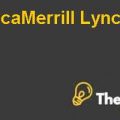Summary:
The Economic conditions of the U.S. are gettingworst day by day with the continuous increase in the inflation and unemployment. The level of customer confidence is also reducing as they are not spending too much on any activity. The two giants in the U.S. retail building supply industry are also affected by this and to improve the profitability they are considering taking many steps such as acquisitions and expansion. Both the companies have already acquired certain companies in the industry which resulted in the reduced competition and they can also achieve economies of scale due to this. Moreover, the industry giants have also introduced themselves in the international markets as well. Home Depot establishes itself in the metropolitan markets while Lowe has positioned itself in the rural markets. The rivalry is high between Home Depot and Lowe and they are considering many similar actions to reduce the dominance of one another.
Answer Number 2:
ROE: The return on equity of Home Depot is 16.8% while the return on equity is 15.3%, the return on investment indicates the returns that the organization’s stockholder's equity is generating. The return on equity of Home Depot is higher than the Lowe’s which suggests the good performance of Home Depots over Lowe’s. The higher ROE of Home Depot might be justifiable due to the higher market share than and privileged earnings than Lowe’s.
Value Line Publishing Harvard Case Solution & Analysis
Gross Margin:Gross margin of Home Depot is also more than Lowe’s margin, which again indicates the superiority of Home Depot over Lowe. The main reason for this increase is the higher sales volume of Home Depot. Furthermore, as Home Depot is amuch larger company than Lowe, Home Depot might be in a better position to reduce the cost of sales, direct costs and direct labor.
Operating Expenses/Sales: The cash operating expenses/sales of Home Depot are higher than Lowe’s, this is also particularly due to the larger size of Home Depot as compared to Lowe. There is a direct relation between the scale of the company and the operating expenses, as the firm grows, the operating costs grows with it. The improved cash operating expenses of Lowe are mainly due to the launch of thewebsite which primarily results in lower operating costs as compared to the traditional retail or wholesale stores.
Total capital turnover and P/E turnover: The total capital turnover and P/E turnover of Home Depot are higher than Lowe’s; this is also suggesting that Home Depot is performing well as compared to Lowe.It is clearly mentioned in the case study scenario that the management of Home Depot is taking aggressive steps to expand its operations, thus, increasing the capital and P/E turnover.
Home Depot’s working capital and receivable turnover are better than Lowe’s. The higher receivable days and working capital turnover have certain implications on Lowe. Firstly, more top receivable days result in increased chances of bad debts, on the other hand, the increased working capital turnover of Home Depot is mainly due to the higher sales. The higher working capital turnover is positively perceived by the investors because the turnover is generating money at a better rate....................
This is just a sample partical work. Please place the order on the website to get your own originally done case solution.









